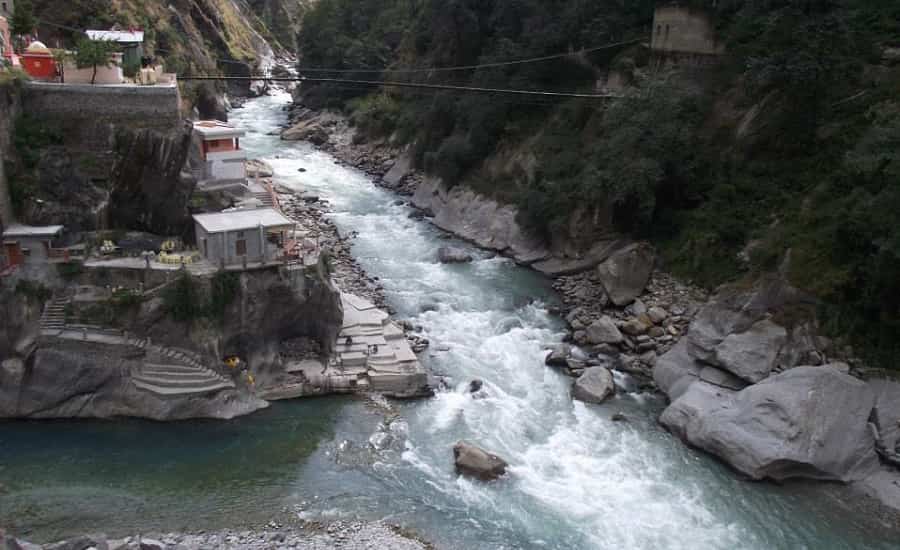The land of Uttarakhand, often called Devbhoomi (the Land of the Gods), is a treasure trove of sacred confluences, temples, and legends. Among its many holy sites, the Prayags hold an extraordinary place. The word “Prayag” refers to a confluence of rivers, a place where waters meet, merge, and carry with them spiritual energy that devotees believe is purifying and transformative. Of the five major Prayags in Uttarakhand — Vishnuprayag, Nandaprayag, Karnaprayag, Rudraprayag, and Devprayag — Vishnuprayag is considered the first confluence in the sequence of the Panch Prayags when one travels from the higher Himalayas downwards.
Located at an altitude of around 1,372 meters above sea level, near the town of Joshimath in Chamoli district, Vishnuprayag is the sacred confluence of the Alaknanda and Dhauliganga rivers. The site is not just about natural beauty; it is deeply immersed in mythology, legends of Lord Vishnu, and centuries of pilgrimage traditions. Unlike more crowded pilgrimage spots, Vishnuprayag retains an aura of tranquility, allowing travelers to witness spirituality blending seamlessly with Himalayan majesty of Vishnuprayag Uttarakhand.
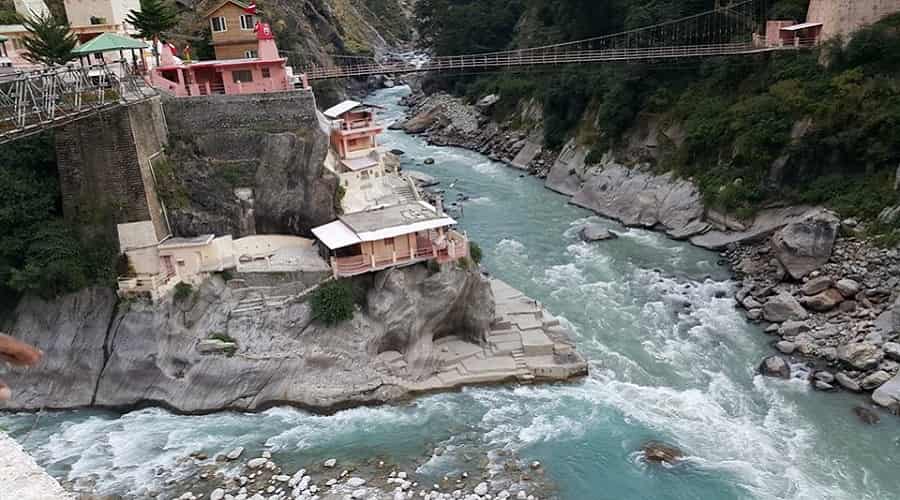
The Mythological Significance of Vishnuprayag Uttarakhand
No pilgrimage site in Uttarakhand is complete without its mythological roots, and Vishnuprayag is no exception. Its legends form the foundation of its sacredness.
Sage Narada’s Tapasya
According to ancient scriptures, Sage Narada, one of the greatest devotees of Lord Vishnu, performed rigorous penance (tapasya) at the spot where the Alaknanda and Dhauliganga meet. Impressed by Narada’s devotion, Lord Vishnu appeared before him at this very site, blessing the sage with knowledge and divine grace. From that moment, the place came to be known as Vishnuprayag, the “confluence of Vishnu.”
The Power of the Confluence
In Hindu tradition, the meeting of rivers symbolizes the union of divine forces. At Vishnuprayag, the mighty Alaknanda joins with the Dhauliganga, their mingling waters representing strength, renewal, and spiritual cleansing. Devotees believe that taking a dip in these holy waters absolves sins and brings peace to the soul.
Connection with the Panch Prayags
Vishnuprayag holds the distinction of being the first Prayag in the sequence of the Panch Prayags. Pilgrims believe that beginning their journey from Vishnuprayag sets the tone for the spiritual cleansing that culminates at Devprayag, where the Alaknanda finally merges with the Bhagirathi to form the sacred Ganga.
The Vishnu Temple at Vishnuprayag
The presence of the Vishnu Temple at the confluence adds to the sanctity of the site.
- The temple is believed to have been commissioned by Maharani Ahilyabai Holkar of Indore in the 18th century, a devout patron of Hindu temples across India.
- It houses a beautiful idol of Lord Vishnu in his revered form as Vishnu Narayan.
- The temple’s stone walls and modest design blend naturally with the surrounding mountains, emphasizing simplicity and devotion rather than grandeur.
Pilgrims often visit the temple to offer prayers before heading further toward Badrinath, as Vishnuprayag lies en route to this major pilgrimage site.
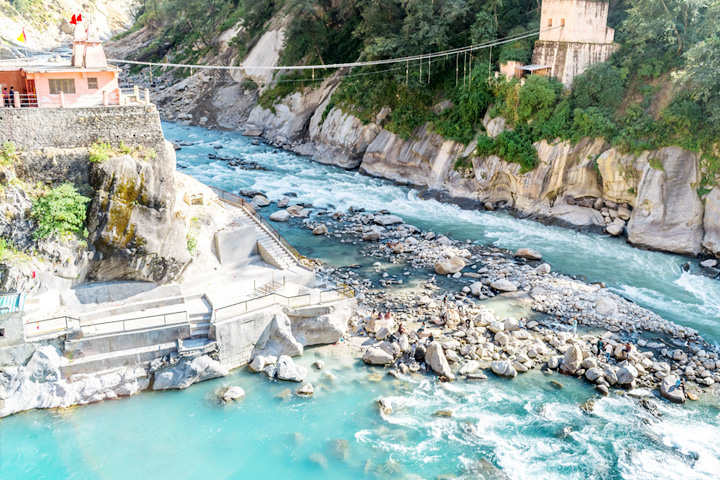
Natural Beauty of Vishnuprayag
While its spiritual appeal is immense, Vishnuprayag’s natural beauty is equally captivating.
- Alaknanda River: Emerging from the glaciers of the Himalayas, Alaknanda is considered one of the main headstreams of the Ganga.
- Dhauliganga River: Originating near the Niti Pass close to the Indo-Tibetan border, Dhauliganga flows through rugged terrains before meeting Alaknanda.
- Majestic Surroundings: Snow-capped peaks, lush green valleys, and the ever-changing hues of the rivers create a mesmerizing view for visitors.
The forceful gushing of waters at the confluence symbolizes raw Himalayan power, making it both awe-inspiring and humbling.
Importance in Pilgrimage
Vishnuprayag plays an important role in the spiritual journey of pilgrims.
Starting Point of the Panch Prayag
- It is the first confluence encountered when traveling downstream from Badrinath.
- Pilgrims consider it auspicious to begin their Prayag darshan here before proceeding to Nandaprayag, Karnaprayag, Rudraprayag, and Devprayag.
On the Route to Badrinath
- Vishnuprayag lies on the road connecting Joshimath and Badrinath, making it a natural stop for devotees heading toward the sacred Badrinath Temple.
- Many yatris pause here to offer prayers, acknowledging the blessing of Lord Vishnu before continuing their journey.
Festivals and Rituals
Like other sacred sites in Uttarakhand, Vishnuprayag witnesses various rituals and festivals throughout the year.
- Makar Sankranti – Devotees gather to take a holy dip in the rivers, marking the transition of the sun.
- Janmashtami – Celebrated with devotion in the temple, honoring the birth of Lord Krishna, an incarnation of Vishnu.
- Local Fairs – The site also becomes a hub for cultural gatherings, where villagers and pilgrims come together in devotion and festivity.
These events bring life to the confluence, blending spirituality with community spirit.
Nearby Attractions
Vishnuprayag is not just a standalone pilgrimage site but also serves as a base to explore many nearby attractions.
1. Joshimath – The Spiritual and Cultural Hub
Just about 13 kilometers from Vishnuprayag, Joshimath is a town of immense spiritual and cultural significance. It is the winter seat of Lord Badrinath, where the idol from the Badrinath Temple is shifted during the harsh Himalayan winters.
- Temples to Visit: The Narasimha Temple, dedicated to Lord Vishnu’s half-lion incarnation, is a must-visit. Legends suggest this temple protects the Badrinath shrine from natural disasters.
- Spiritual Importance: Joshimath is one of the four mathas (monastic centers) established by Adi Shankaracharya, making it a prominent site in Hindu philosophy and tradition.
- Gateway to Adventures: It is also the starting point for excursions to Auli, Tapovan, and trekking trails leading to Niti Valley.
Joshimath blends spirituality with local charm, offering travelers both peace and cultural richness.
2. Auli – The Skiing Paradise of India
Located about 20 kilometers from Vishnuprayag, Auli is a dream destination for nature lovers and adventure seekers. Known for its ski slopes and panoramic views of Nanda Devi, Auli attracts tourists from across the world.
- Winter Sports: Skiing, snowboarding, and cable car rides are major attractions during the winter months.
- Year-Round Beauty: In summer, the meadows bloom with alpine flowers, and the region offers fantastic trekking opportunities.
- Auli Ropeway: One of Asia’s longest cable cars, it connects Joshimath to Auli, offering breathtaking aerial views of the Himalayas.
Auli is not just about adventure; it is a visual treat for anyone who wants to immerse themselves in Himalayan landscapes.

3. Tapovan – Meadows and Hot Springs
A short journey from Joshimath brings you to Tapovan, a serene location famous for its hot springs and lush meadows. Surrounded by snow-covered peaks, Tapovan is an excellent spot for both relaxation and trekking.
- Hot Springs: The naturally heated water is believed to have medicinal properties. Pilgrims and trekkers often take a dip here for rejuvenation.
- Trekking Routes: Tapovan serves as a base for treks deeper into the Nanda Devi National Park region.
- Photography Spot: The backdrop of towering Himalayan ranges makes it a paradise for photographers.
Tapovan offers a perfect mix of nature’s healing power and Himalayan adventure.
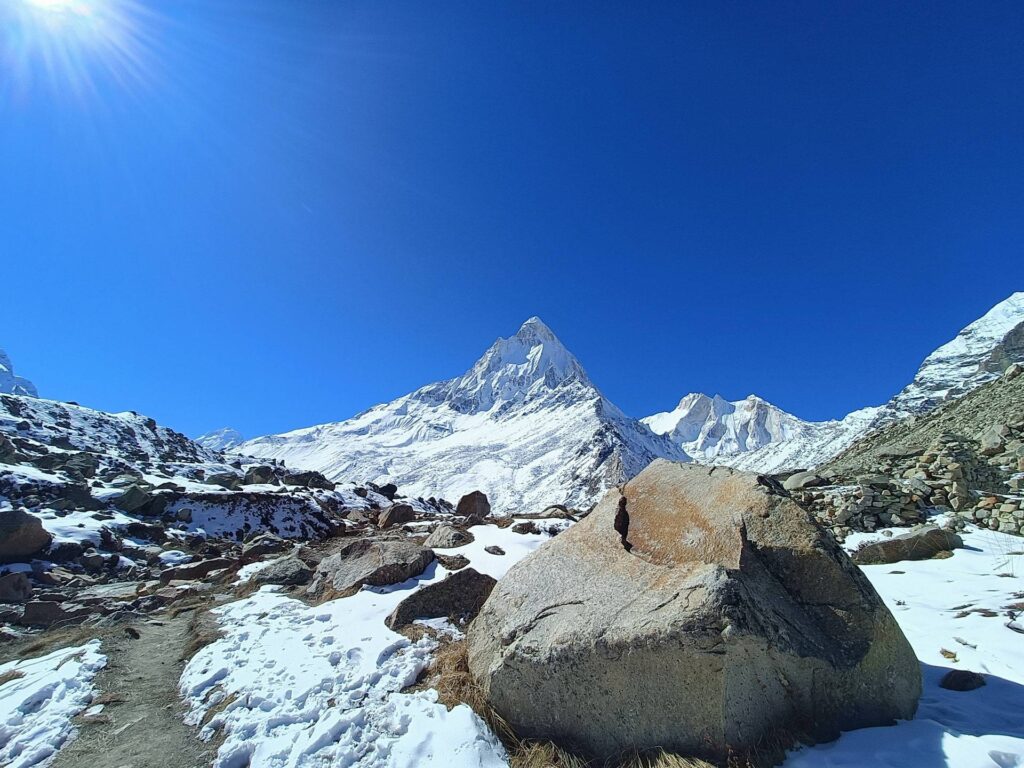
4. Valley of Flowers – A UNESCO World Heritage Site
One of the most iconic attractions near Vishnuprayag is the Valley of Flowers National Park, located about 40 kilometers away (trek begins at Govindghat, near Joshimath).
- Biodiversity Haven: The valley is home to more than 500 species of alpine flowers that bloom during the monsoon months of July and August.
- Scenic Trek: The trek to the valley takes you through dense forests, river crossings, and picturesque landscapes.
- Spiritual Feel: Many visitors describe the valley as a place where nature itself feels divine.
For travelers, it is a once-in-a-lifetime opportunity to witness nature’s brilliance in full bloom.
5. Hemkund Sahib – A Sacred Sikh Pilgrimage
Another nearby gem is Hemkund Sahib, a revered Sikh shrine located at an altitude of over 4,000 meters.
- Pilgrimage Trek: Starting from Govindghat, the trek to Hemkund Sahib is challenging but rewarding, offering breathtaking views at every turn.
- Spiritual Significance: The gurdwara, located beside a serene glacial lake, is dedicated to Guru Gobind Singh, the 10th Sikh Guru.
- Natural Beauty: Surrounded by seven snow-clad peaks, the site is as much a natural wonder as it is a place of devotion.
Hemkund Sahib draws not just Sikh pilgrims but also adventurers and nature lovers from across the globe.
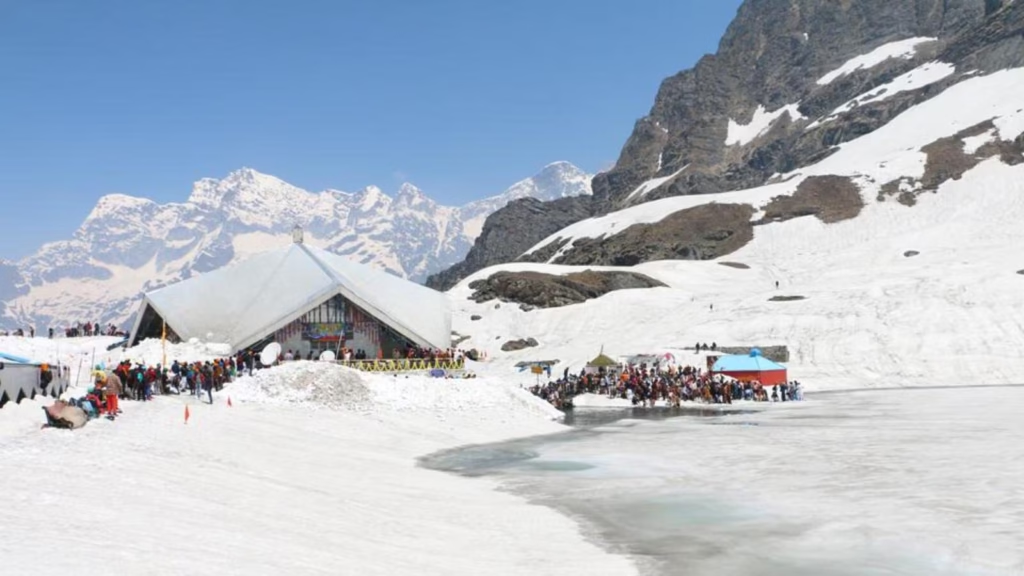
6. Niti Valley – Offbeat Himalayan Beauty
For those who love exploring less-crowded destinations, the Niti Valley near Vishnuprayag is a hidden treasure. Located close to the Indo-Tibetan border, the valley is known for its rugged terrain and raw Himalayan charm.
- Traditional Villages: Villages like Niti and Gamshali showcase traditional Himalayan life, architecture, and culture.
- High-Altitude Treks: The valley opens the gateway to several treks and trails that offer majestic views of glaciers and peaks.
- Cultural Blend: Due to its proximity to Tibet, the valley reflects a fascinating mix of Indian and Tibetan influences.
Niti Valley is perfect for travelers who want to explore the untouched beauty of the Himalayas.
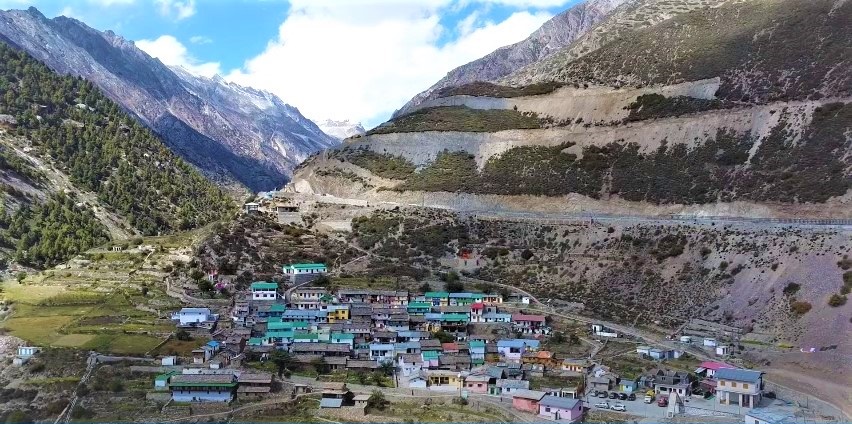
7. Badrinath – The Sacred Dham
No journey from Vishnuprayag is complete without mentioning Badrinath, one of the Char Dham and the most revered shrine of Lord Vishnu. Located about 47 kilometers from Vishnuprayag, it is easily accessible by road.
- Badrinath Temple: Situated on the banks of the Alaknanda, the temple is one of India’s holiest pilgrimage sites, drawing thousands of devotees each year.
- Mana Village: The last Indian village near the Indo-Tibetan border, located close to Badrinath, is famous for sites like Vyas Gufa and Bhim Pul.
- Spiritual Journey: Visiting Badrinath after stopping at Vishnuprayag feels like completing a divine circuit of devotion.
Badrinath combines spiritual intensity with the grandeur of Himalayan landscapes, making it a must-visit.
These destinations make Vishnuprayag an important stop for both pilgrims and tourists.
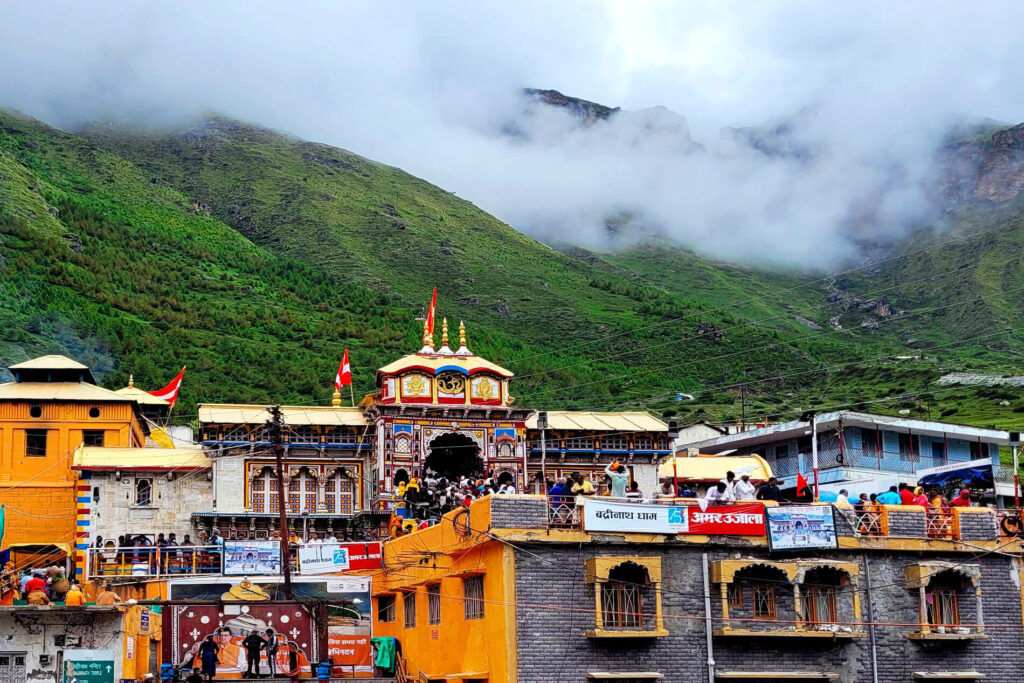
How to Reach Vishnuprayag
Reaching Vishnuprayag is convenient compared to higher Himalayan shrines.
- By Road: Vishnuprayag lies about 13 km from Joshimath on the Badrinath road. Buses and taxis are available from Haridwar, Rishikesh, and Dehradun.
- By Rail: The nearest railway station is Rishikesh, about 260 km away.
- By Air: Jolly Grant Airport in Dehradun, around 280 km from Vishnuprayag, is the closest airport.
- Trekking Options: For those who enjoy walking, the short routes from nearby villages offer scenic trails leading to the confluence.
Why Visit Vishnuprayag?
There are several reasons why Vishnuprayag should not be missed:
- To witness the spiritual energy of the first Prayag.
- To enjoy the spectacular confluence of Alaknanda and Dhauliganga.
- To connect with the mythology of Sage Narada and Lord Vishnu.
- To explore nearby cultural and natural attractions.
- To begin the Panch Prayag pilgrimage with divine blessings.
Conservation and Challenges
Like many Himalayan sites, Vishnuprayag faces challenges:
- Hydroelectric projects on Dhauliganga and Alaknanda pose ecological risks.
- Erosion and landslides in the region impact accessibility.
- Unregulated tourism may disturb the delicate balance of nature and spirituality.
Efforts by local authorities and pilgrims are essential to preserve Vishnuprayag as a sacred and natural heritage site.
FAQs for Vishnuprayag
- Where is Vishnuprayag located?
Vishnuprayag lies near Joshimath in Uttarakhand, at the confluence of the Alaknanda and Dhauliganga rivers. - Why is Vishnuprayag sacred?
It is believed that sage Narada meditated here and Lord Vishnu blessed the site, making it spiritually significant. - Which rivers meet at Vishnuprayag?
The Alaknanda and Dhauliganga rivers merge at this confluence. - Is there a temple at Vishnuprayag?
Yes, the Vishnuprayag Temple dedicated to Lord Vishnu is located here. - What is the altitude of Vishnuprayag?
It is situated at around 1,372 meters (4,500 feet) above sea level. - How is Vishnuprayag connected to Panch Prayag?
It is the first of the five sacred confluences (Panch Prayag) in Uttarakhand. - What is the best time to visit Vishnuprayag?
April to June and September to November are ideal for visiting due to pleasant weather. - How to reach Vishnuprayag?
It can be reached by road from Joshimath, with nearest railhead at Rishikesh and airport at Jolly Grant, Dehradun. - What activities can tourists do at Vishnuprayag?
Pilgrims offer prayers at the temple, while tourists enjoy scenic river views, photography, and meditation. - Is Vishnuprayag part of Char Dham Yatra?
Yes, it lies on the route to Badrinath and is visited by devotees as part of the Char Dham pilgrimage.

